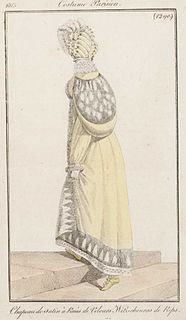 W
WCieszyn folk costume, also known as Valachian, is a Silesian folk costume, which used to be worn within majority of the area of Cieszyn Silesia, but mostly by Cieszyn Vlachs. Taking into consideration ornamentation, cutting and materials, it can be observed that it is a replica of historical costumes of the Renaissance. The male folk costume was worn only to the late 19th century, whereas the female folk costume was more popular and spread in the vicinity of the Wisła, Istebna and Koniaków. Previously in this area the costumes of Silesian Gorals prevailed. Female folk costumes in Cieszyn were subjected to many changes, especially in respect to ornamentations and better quality of materials. Due to its richness and elegance the costume quickly became a target of artists and specialists in folk culture.
 W
WCrakows or crackowes were a style of shoes with extremely long toes very popular in 15th century Europe. They were so named because the style was thought to have originated in Kraków, then the capital of Poland. They are also known as poulaines or pikes, though the term poulaine, as in souliers à la poulaine, "shoes in the Polish fashion", referred to the long pointed beak of the shoe, not the shoe itself.
 W
WCzamara was a type of outer garment in the Polish–Lithuanian Commonwealth. It was worn there from the 16th century and came to the Commonwealth via Hungary from Turkey. It was first worn mostly by priests, and in the 18th century became a popular attire of (non-nobility) burghers. In the 19th century, the czamara became a notable element of male Polish national and patriotic attire.
 W
WThe delia is a garment worn by male szlachta (nobility) of the Polish–Lithuanian Commonwealth. The delia is similar to a coat or cloak, and was worn over the żupan from the 16th until the early 18th century.
 W
WFolk costumes from Podhale region - costumes wear by Highlanders (Gorals) in Polish area of the Tatra Mountains, Podhale region. Unlike other regional groups in Poland, Highlanders from Podhale wear traditional outfit on a daily basis. This type of outfit is widely considered one of the Polish national costumes.
 W
WKontusz - a type of outer garment worn by the Hungarian and Polish-Lithuanian male nobility. It became popular in the 16th century and came to the Polish–Lithuanian Commonwealth rule via Hungary from Turkey. In the 17th century, worn over an inner garment (żupan), the kontusz became a notable element of male Polish national and Zaporozhian cossack attire.
 W
WA parzenica is a heart-shaped traditional handicraft pattern and decorative folk art of the Goral people, who live in the mountainous region of southern Poland. It is often found embroidered on the upper front side of men's trousers.
 W
WKontush belt was a cloth sash used for girding a kontusz. It was one of the most distinctive items of male dress of Polish and Lithuanian nobility (szlachta) from about 17th through the 19th centuries. In an earlier period, sometimes narrower sashes of fine cloth or silk net were worn, but the wide kontusz sash is specific to the later period.
 W
WNational costumes of Poland vary by region. They are not worn in daily life but at folk festivals, folk weddings, religious holidays, harvest festivals and other special occasions. The costumes may reflect region and sometimes social or marital status.
 W
WA sukmana is a type of traditional coat once worn by peasants in Poland, and some other Central European countries, as well as Hungary. It was particularly common from the 18th to early 20th centuries. It was made from a simple, hand woven wool fabric comparable to russet cloth, and usually retained its natural white or grayish color. The coat was long, with sleeves, and wider towards the lower parts.
 W
WA witzchoura was a type of mantle, pelisse, or sleeved cloak, with a large collar and, sometimes, a hood, that was particularly fashionable in the early 19th century. The term derives from the Polish word wilczura, meaning 'wolf fur coat'. It was inspired by Polish styles, hence sometimes being described as a la Polonaise, although it is not the same as the gown called a polonaise. Like the original hussar's pelisse, it was typically lined with fur.
 W
WŻupan is a long lined garment of Turkish origin which was worn by almost all males of the nobility in the multi-ethnic Polish–Lithuanian Commonwealth and by Ukrainian Cossacks in the Hetmenate. It was a typical upper class male attire from the late 16th to the first half of the 18th century.